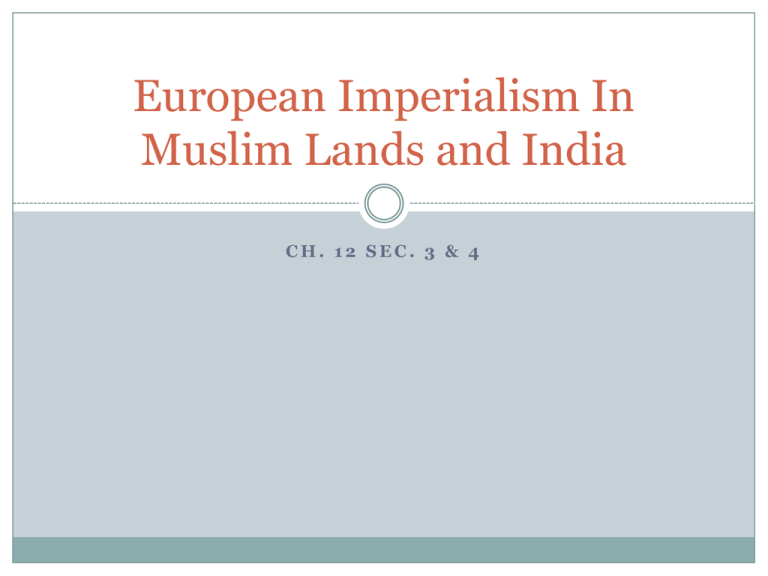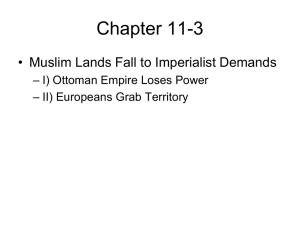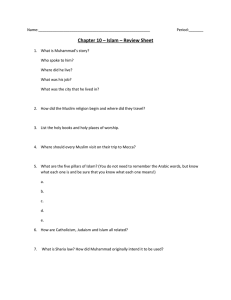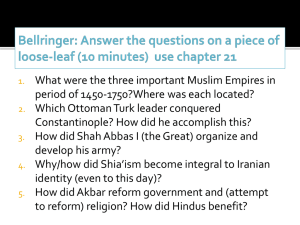European Imperialism In Muslim Lands and India
advertisement

European Imperialism In Muslim Lands and India CH. 12 SEC. 3 & 4 European Empires in Muslim Lands Objectives • Analyze the sources of stress in Muslim regions. • Explain the problems the Ottoman empire faced. • Describe how Egypt sought to modernize. • Understand European interest in Persia. Three great Muslim empires—the Ottomans in the Middle East, the Safavids in Persia, and the Mughals in India—were in decline by the 1700s. Napoleon’s Egyptian campaign opened a new era of European contact with Muslim regions. European countries had established footholds at the edges of Muslim countries. Before long, they would strike at their heartland. A number of internal factors contributed to the declines of the three Muslim empires. • Landowning nobles, military elites, and urban craft guilds had gained power. • Corruption was widespread. • In some places, scholars and religious leaders stirred up discontent. In addition, each empire faced strong competition from growing European powers. A number of reform groups stressed piety and strict rules of behavior and rejected Western influence. • Usman dan Fodio led the struggle to reform Muslim practices in northern Africa. • In Sudan, Muhammad Ahmad claimed to be the Mahdi, or savior. • In Arabia, the Wahhabi movement called for a return to the simplicity and purity of Muhammad’s day. At its height, the Ottoman empire extended across the Middle East, North Africa, and Southeastern Europe. The Ottomans faced internal decay and foreign challenges. Nationalist revolts, especially in the Balkans and Egypt, threatened the empire, while local pashas grew bolder. The Russians, Germans, and British all sought to capitalize on the Ottoman’s growing weaknesses. Ottoman rulers tried to adopt reforms in the late 1700s. • The bureaucracy and tax systems were reformed. • Education was expanded. • Europeans advised on military training. • Young men were sent to the West for technological and scientific training. But reforms did not always help. • Improved health brought a population explosion and increased competition for land. • Many local sultans objected to Western ideas that threatened their autonomy and power • Reformers called “Young Turks” pressed for liberal reform but were stopped by World War I. Muhammad Ali, appointed governor by the Ottomans, modernized Egypt in the early 1800s. • Tax collection was improved, and the landholding system was reorganized. • Large irrigation projects expanded farming. • Cotton and other industries were promoted. • Military modernization led to the conquest of weaker neighbors. After Muhammad Ali, Egypt came under increasing control of foreigners. • In 1858, a French entrepreneur, Ferdinand de Lesseps, organized a company to build the Suez Canal linking the Mediterranean to the Red Sea. • The English gained control of the canal when one of Ali’s successors fell into debt to Britain. • Opened in 1869, the 100-mile-long Suez Canal cut the distance for ships traveling from India to London by over 5,000 miles. • It kept Egypt at the crossroads of the world. In 1882, Egypt became a British protectorate. In theory, the governor was still an official of the Ottomans. In fact, he followed policies dictated by Britain. Egypt continued to modernize under British rule. But nationalist discontent continued. The Safavid empire also fell under outside influence. . Teheran Persia Borders of the Safavid empire, 1629 • The Qajar shahs held power in Persia from 1794 to 1925. • They took steps to modernize, such as building rail and telegraph lines and experimenting with constitutional government. The British Take Over India Objectives • Understand the causes and effects of the Sepoy Rebellion. • Explain how British rule affected India. • Describe how Indians viewed Western culture. • Identify the origins of Indian nationalism. For more than 200 years, Mughal rulers governed a powerful empire in India. By the mid-1700s, however, the Mughal empire was collapsing from a lack of strong rulers. Britain then turned its commercial interests in southern Asia into political interests and gained control of India. In the 1600s the British East India Company won trading rights on the fringe of the Mughal empire. •As the Mughal empire declined, the British gained control. •By the mid-1800s the company controlled about three fifths of India. The Mughal Empire Although the East India Company’s goal was to make money, British policies aimed to improve India as well. • The British improved roads, reduced banditry, and introduced Western education and legal procedures. • They pushed for social changes such as ending slavery and the caste system. • British officials banned sati, a custom in which a wife was expected to kill herself on her husband’s funeral fire. British insensitivity to local customs led to the bloody Sepoy Rebellion in 1857. • The sepoys were Indian soldiers hired to fight for the British. • The British issued a number of rules that angered the sepoys and finally provoked them to rebel. After the Sepoy Rebellion, Britain took control of India from the East India Company. • Parliament placed India directly under the British crown. • Britain sent troops to India and taxed Indians to pay for them. • Indians were angered at how Britain extracted great wealth from India. Parliament set up a system of colonial rule called the British Raj. • A British viceroy ruled in the queen’s name. • High officials were British, but Indians held lower posts. • With some local cooperation, India became the crown jewel of the British Empire. Indians were divided in their attitudes toward modernization and Britain. Upper-class and educated Indians adopted more modern ways. Hindu and Muslim religious leaders opposed British-style modernization. The British were also divided in their attitudes toward Indian culture. As Indian classics were translated, many Englishmen gained respect for Indian literature and religious ideas. Paternalistic English leaders such as historian Thomas Macaulay had little respect for other cultural traditions. British leaders provided promising young Indians with a British education, thinking this would lead them to accept British culture and rule. Instead, educated Indians returned home and began nationalistic movements. • The Indian National Congress formed in 1885 to propose selfrule within the British Empire. • Muslims feared that Hindus might dominate any government. In 1906, they founded the Muslim League and soon began talking about a separate Muslim state.





